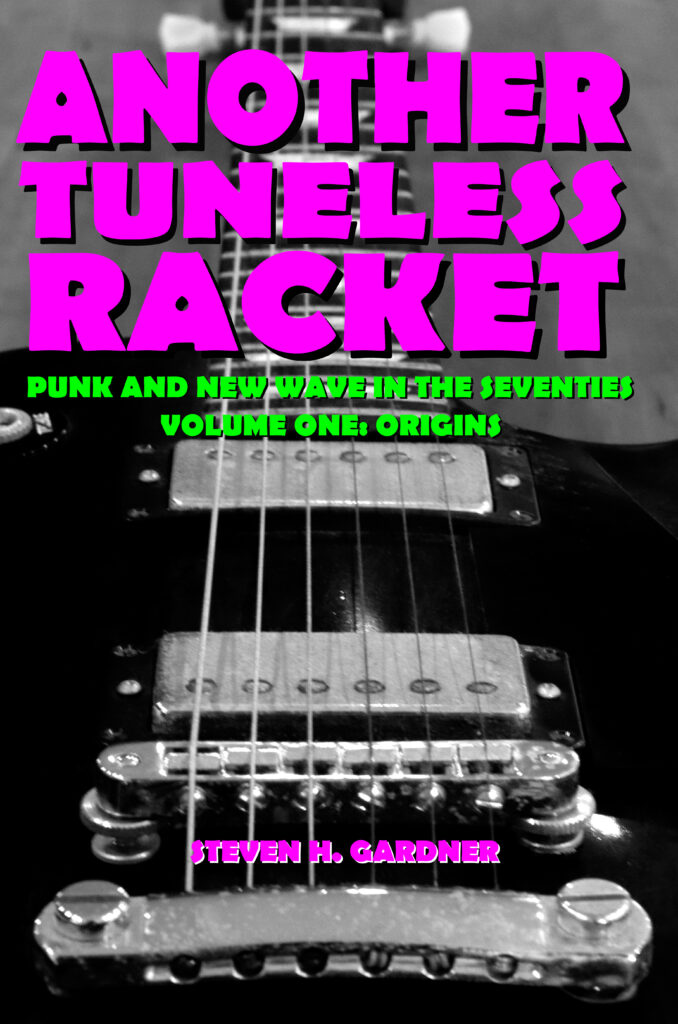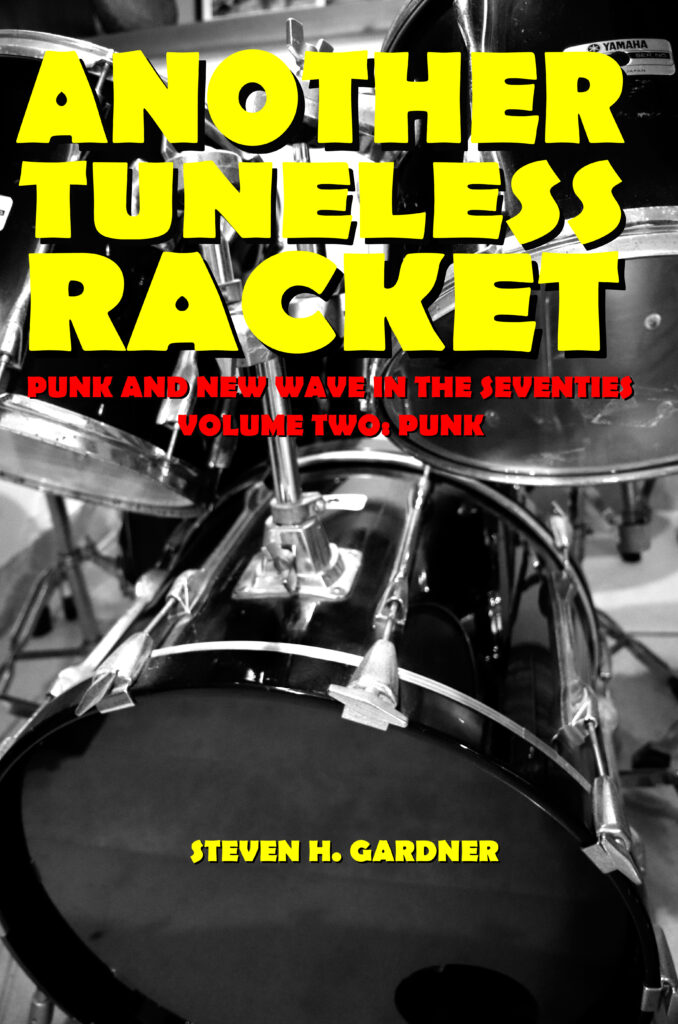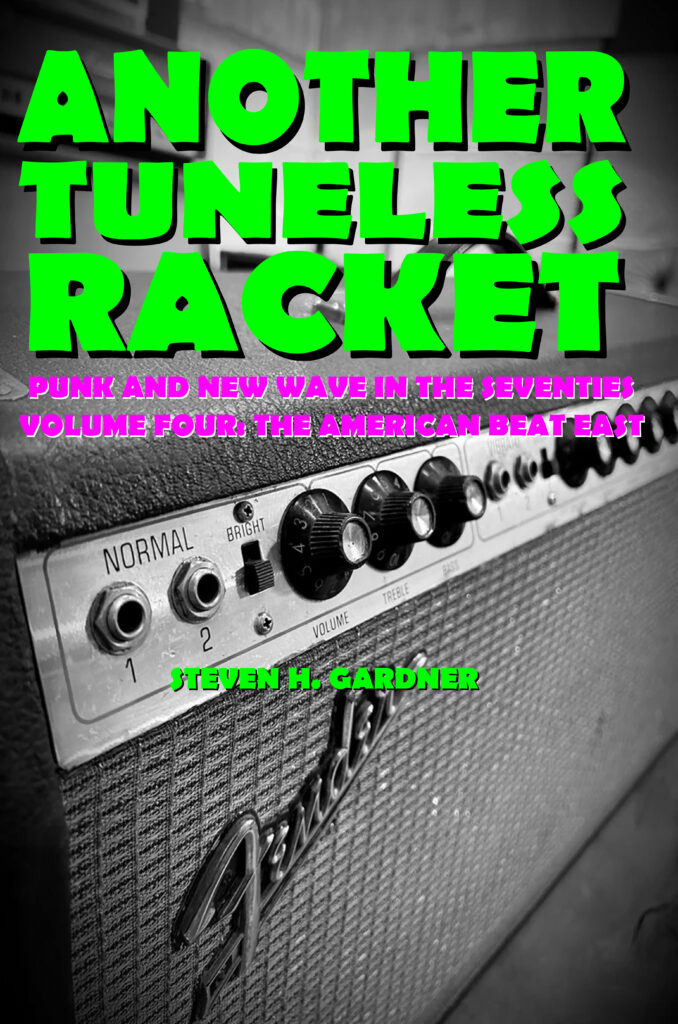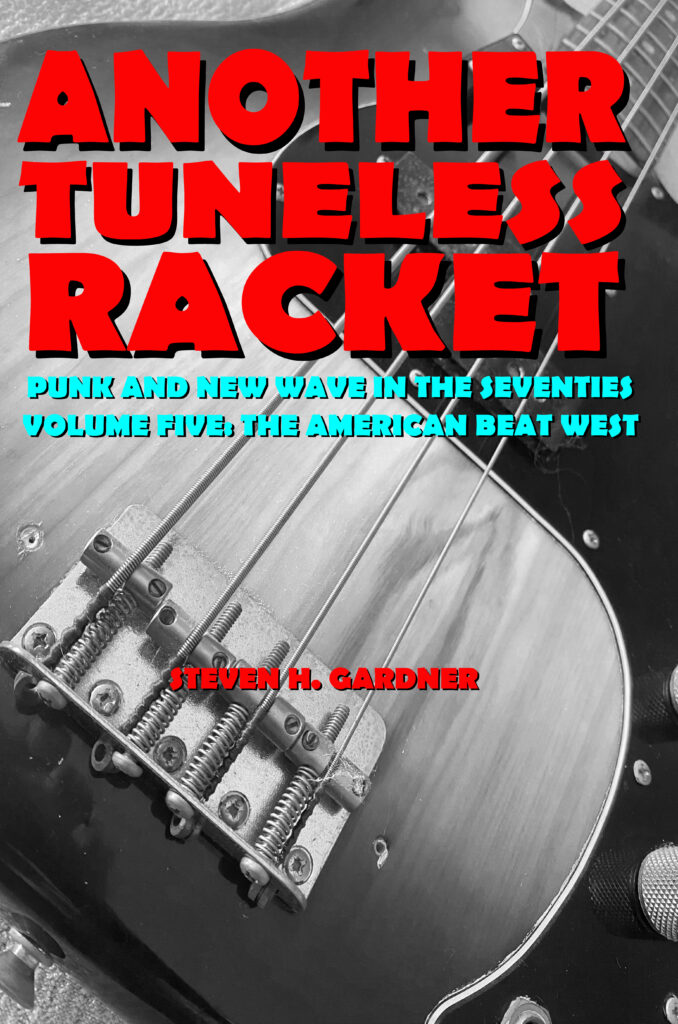
By Steven H. Gardner
The story of punk rock overthrowing the old rock music order has, by now, been told in countless retrospective magazine articles and books, many of which are highly entertaining and some even essential. Yet the story that emerges from these tends to be slanted towards the iconic bands of the day. You know the names: the Clash, Pistols, Jam, Damned, Ramones, Blondie, Talking Heads, etc.
These bands certainly deserve all the praise we can give, but elevating them to a godlike status can make people overlook the very important fact that punk was, above all else, an icon-smashing endeavor fielded by a legion of everyman (and -woman) contributors wanting more than just to observe. The punks of the ’70s wanted to participate by playing in bands, of course, but they also ran labels, owned venues, recorded their own music, started record labels, hosted punk shows on the radio and published their own fanzines and magazines. Success was uneven, but everyone who tried contributed to the punk ecosystem.
Another Tuneless Racket, a monumental book series of five volumes (with a sixth in progress), attempts to tell the story of the first four years of punk from this activist viewpoint, providing opinionated in-depth coverage not just to the well-known bands but also to the scenes and smaller bands that provided the environment in which punk could take root.
- Volume One: Origins describes bands that pre-figured the development of punk and explores the attitudes that made the teenagers of the mid-’70s decide that the heroes of the 1960s were past their sell-by date.
- Volume Two: Punk focuses on the first generation of bands in the U.S. and UK, but also Canada, Australia and France, playing at a time when “punk” meant something very different from what it came to mean four years later.
- Volume Three: UK New Wave then zeroes in on the second generation of bands coming out of the British Isles.
- Volumes Four and Five: The American Beat East and West, respectively, provide a deep dive into the scenes around the USA. Volume Six, in progress, will cover bands from the rest of the world. (SHG)
These massive books (the shortest is 466 pages; three of the volumes are in the 700-page range) go deep and wide, covering countless bands, scenes and people. Gardner combines incredibly in-depth research with new interviews, period citations, reviews and his own analysis and appreciation into an exhaustive dive into an era and its proponents. What’s more, the excellent quality of the writing in this tsunami of information belies any tradition of punk/fanzine carelessness. These are definitive doorstops you can’t put down that should be in every rock library.
The following excerpt, written in 2019, is the preface to the first volume and appears here by permission of the author.
—Ira Robbins

I turned 21 in the summer of 1976, the year that many people who think about such things consider to be ground zero for punk rock. The future was a long way away, and to be honest I didn’t spend a lot of time thinking about it. But on the rare occasion when I became sufficiently introspective to envision my older self, I assumed I’d be fat, balding, wearing wing-tipped shoes rather than basketball sneakers, slacks rather than torn jeans, and an Oxford shirt buttoned down the chest rather than a T-shirt with a band name on it. I’d have 2.3 kids who I would berate for having no ambition, hair that was too long and appalling musical taste. That’s how everyone else who was then in their future had turned out. Why should I expect to be different?
Oh, and I assumed that in that future I’d get tired of the loud rock and roll music I listened to constantly at the time, and that all the records I had accumulated would eventually find their way out of my house into the local second-hand shop, to be replaced by something soothing like Tony Bennett. It wasn’t like it was anything to be ashamed about; it was just the process of maturity, which at the age of 21 seemed like the last step in life before one’s funeral. It was inevitable, like the sun becoming a supernova and turning the Earth into a cinder. The idea is pretty horrible, but you can’t do anything about it, and it’s a long way off, so why worry?
Except something funny seems to have happened. I think I’m in the future now. I’m 64, and if this isn’t the future, it had better plan on getting here pretty damn quick or I won’t be around to see it. And as I write this, sitting here in jeans, T-shirt and basketball shoes, not as fat as I’d anticipated, running my hand through my still present but rather whiter hair, in a room that not only contains all the records I had when I was 21 neatly arranged on shelves, but also another several thousand purchased since then, I’ve just put on the 1977 album Damned Damned Damned. And you know what? Not only does it still sound infinitely better to me than a Tony Bennett album, but I still have enough adolescent humor to laugh at the juvenile record cover with the four guys having just cream-pied each other in the face. It turns out that maybe Pete Townshend jumped the gun on that whole “hope I die before I get old” business.
It is said (mostly by old people who regretfully realize they haven’t made much of themselves and wish they could have a do-over) that youth is wasted on the young, but it always struck me as funny that no young person ever retorts that age is wasted on the old. Age has its advantages if you only care to use them, but unfortunately most people don’t. A lot of this is because work beats them down. Going to an office for ten hours a day in a job that requires you to spend all your brain energy thinking for a company is a good way to kill off any creativity you might have had for outside efforts, and it takes some real fighting to maintain some independent drive. We are becoming a world of people who are just thinking machines, and when the work day is done people want to stop thinking and rest their brain. So, the TV goes on and everybody just assumes this is life: sleep, coffee, car, work, car, kids, car, TV, sleep, repeat. Career opportunities indeed.
But as Mose Alison sang, it’s the old people who’ve got all the money, and it’s also the old people who always talk down to young people. Age brings position, influence, experience and, compared to what kids have, wealth. But if you don’t use it to accomplish something, what good is it? It makes me grind my teeth when I hear people my age who I know pissed off their parents 40 years ago by smoking dope and having their hair down to their shoulders moaning about millennials and their tattoos and attitudes, when those kids ought to be asking my generation and the hippies before that to explain how we managed to fuck up the world so badly despite all our high-flying rhetoric.

And sometimes they have asked, through the medium of music. Which is one of the reasons I still like listening to all those punk rock records, because although a lot of the songs are just fun, and some are silly and meaningless, and there were others that were nasty and contrarian, there are a few that really said something to me about how I should think about things and how I should behave. People who never listened to punk music tend to think of punks as a pack of near-rabid animals bent on destroying society, and in truth there really was a little whiff of that in places, but the image is largely a media construct. (It’s also worth noting that there were a lot of hippie bands that got out of their heads on drugs and sang about revolution and overthrowing society, yet today everybody looks on their era as a golden age of peace and love. They had better generational marketing, I suppose.) There was in fact a good deal of thoughtfulness in a lot of punk music, especially considering how many of the songwriters were barely entering their twenties. The best parts can still serve as useful life markers for people of any age.
But 1976 was an awfully long time ago. I often have to remind myself that punk didn’t start during the time of Reagan and Thatcher. It didn’t even start in the time of Carter and Callaghan. You have to go back to Gerald Ford[1] and Harold Wilson. So today might not be the future, but that was sure as hell the past.
I think the word revolution is over-used in talking about music, since in retrospect you can always draw clear lines from what came before to where things ended up. These lines don’t necessarily follow the main pathways of popular music, and they might go down some pretty dark and dirty back alleys, but they do exist. Be that as it may, punk was certainly a big change in music. In a feature with Uncut magazine, Damned drummer Rat Scabies[2] was asked about the significance of the Ramones playing at the Roundhouse in London in 1976 and how that had influenced British punk. Scabies responded that the whole argument about who came first was irrelevant. What mattered was that the same thing was happening around the world. The next generation felt held down by the previous one. They were being force-fed a tired youth culture of peace signs, love beads, tie-dyed shirts and joss sticks that wasn’t theirs, and they were getting bloody pissed off about it.
And this around-the-world nature of punk is clearly true. Punk would never have gotten traction if there wasn’t a desire among at least some music fans to want the kind of music the bands were making. In the mid-1970s, that desire was in the air breathed by bands and fans alike. It’s the reason that the era witnessed the almost simultaneous launches of the Saints and Radio Birdman and the Victims in Australia, Toy Love or Spelling Mistakes in New Zealand, Little Bob Story, the Dogs, Telephone and Stinky Toys in France, Big Balls and the Great White Idiot in Germany, the Diodes, Viletones and Teenage Head in Canada, Rocket From the Tombs and then Pere Ubu and the Dead Boys in Cleveland, Devo and the Bizarros in Akron, scenes at CBGB, the Rat, the Masque and the Mabuhay Gardens, and the host of UK outfits at the Roxy, the 100 Club, the Electric Circus and Eric’s. All these bands would have accomplished nothing if there weren’t people ready to hear what they were playing, which was something that the bands on the radio were most emphatically NOT playing. And everybody fed off everybody else to some extent, even if it was just encouragement that what they were doing in some way made sense.

Nowadays it seems like kids listen to everything, which I think is partly because they don’t use music as much as a form of self-identity as used to be the case. I can’t imagine ever wanting to listen to music that my parents liked, yet my nephew who is 35 years younger than me liked the Clash and Ramones when he was in high school and still does, I think. But generational turnover in rock music used to be pretty fast. For most people, the period during which music got under their skin and became part of the fabric of their nature was only four to six years long. They might have started listening to music when they became a teenager, but when they hit 18 or 19, they began to become embarrassed about the things they liked when they were kids. And by 24 or 25, they started thinking that current music is all crap. They locked in the idea that the time from when they were 18 until they were 24 was when the good music was made.
So under any circumstance, the bands that had made great records in the first couple years of the ’70s (and there were a lot more of them than history gives credit for) were near the end of their sell-by date, but they seemed to make it worse by reaching for something like “maturity,” playing music for people who thought that if they were going to end up with collections of Tony Bennett records they might as well get started on it. One after the other the great bands of the past came out with records that had all the fun and joy and anger and pain, all the emotion, squeezed right out of them.
A big part of the change in the music environment was caused by the rapidly increasing impact of money as a significant factor in rock. Like the Brains sang in their terrific 1980 song, money changes everything. In the mid-’70s, bands that had been playing for the sheer joy of creating music began realizing that chart position equated to money. They had managers and record company executives shouting in their ears about how they needed to reach a larger audience and telling them what it would take to do it. You could have fun playing for your fans. But you made money playing for consumers. More and more people could afford stereo systems and record players, and they were buying records to play on them at the same rate they ate hamburgers. Data from the RIAA shows that in 1975, about 250 million LPs were sold in America. In just three years, by 1978 sales volume approached 350 million. What drove this growth was the rise of consumer-oriented rock: music meant to be consumed like potato chips or milkshakes.
Two bands that might have been the primary examples of this changed viewpoint were Fleetwood Mac and Jefferson Starship. Both had been respected bands in the ’60s, Fleetwood Mac for their inventive British blues, and Jefferson Starship (at the time Jefferson Airplane) for being at the front of the Haight-Ashbury axis of acid rock groups. But by the early ’70s, both bands were viewed as totally irrelevant, and when they released records, the time between the initial ship date and their appearance in mark down bins was measured in weeks at the most. Both bands hit on the same solution: stop trying to be innovators and instead make music that appealed to the kinds of fans who didn’t think too hard about music and wanted pleasant-sounding songs about love interests. And it worked. Songs like “Miracles” and “Rhiannon” vaulted both bands off the examination table in the pathology ward to mega-platinum success.
Nobody could possibly say that in 1976 Fleetwood Mac were in it for anything but money. Who in their right mind would want to play bass in a group with their ex-wife who was making whoopee with the stage lighting guy and crooning “You make lovin’ fun / It’s all I want to do” if it wasn’t because it kept the gravy boat topped up? That’s not something you do for fun or art.
Consumer-oriented rock music wasn’t something totally new, but in the past it had been geared around getting airplay on AM radio rather than driving record sales. The idea that bands that had previously demonstrated a degree of artistic integrity would suddenly start making “giving the people what they want” the primary reason for their existence in order to make as much money as possible was something new, and one group after another took a stab to see whether the Fleetwood Starship model would work for them.
And some rock fans felt it. They might not have been able to put their finger on it, but they knew rock and roll had lost something. The old bands were out of gas, out of energy and out of ideas. The average record consumer was OK with that, but the ones that felt something wasn’t right went looking for anything with an edge, with some rawness, with some emotion. These people weren’t confined to one place. They were everywhere people had been listening to rock music for the last 20 years. Not just in London or New York, but in every place with any attachment to western culture. So, you could be a guy who grew up in, oh, let’s say a town of under a thousand people with no traffic lights in southern Vermont, and still be looking for what a band like Radio Birdman had on offer in Sydney, Australia. I know: I was that guy. And this book is about how I sidestepped Tony Bennett and learned that you could be a punk rock fan for life.

At some point I expect that the serious people who worry seriously about things like art are going to come to the realization that the two dominant forms of artistic expression in the second half of the twentieth century were film and pop music, and they let it slip right past them while they were looking at performance artists painting portraits of politicians with dog poop or making sculptures out of used plastic Coke bottles. There’s not much argument about film at this point, but pop music still isn’t treated as seriously as it deserves to be. Never mind, it will come. Because far from being the fad that rock and roll was once proclaimed to be, it has proven to be a lasting and culture-changing music. Competing forms like poetry have been pushed into the shadows, because after all, since the mid-1950s the best poets have mostly used music as the soundtrack for their verse.
I imagine a day not too far from now when critics and experts find themselves digging through scanty clues trying to understand how the different branches of pop music came to be, writing expansive PhD theses describing the chains of influence, but struggling from the dearth of evidence and getting it wrong because — although the sources of recorded music are vast and lasting — the details of how that music got made, what the people in the bands were trying to do and whose shoulders they stood on for inspiration are in grave danger of being lost. It’s already happening. The many books about rock and roll that have appeared in the last thirty years are starting to make the past congeal into a story that often isn’t very accurate.
It’s hard to avoid this, because many people got their version of the story second-hand and the original tellers had their own version of the facts to present to suit their purposes. I have no doubt that what I’ve written here is subject to plenty of my own prejudices. But I’ve listened to the punk and new wave of the late 1970s since the middle of that decade, when the bands were current. I’ve seen a lot of the bands play live, I’ve read the articles written about them in their heyday, and I’ve even written about them myself — first in my own fanzine Noise for Heroes and later in Jack Rabid’s superb The Big Takeover.
If you look at the birth years of rock stars from the pre-punk era, they are usually in the mid-1940s. But the major punk figures are mostly from the mid-1950s, with 1955 being more or less the center year. Anyone born in 1955 was twenty-one in 1976; just the right age to decide you are going to put everything you have into a band[3]. Steve Jones of the Sex Pistols, Pete Shelley of the Buzzcocks, Cheetah Chrome of the Dead Boys, Clem Burke of Blondie, Brian James of the Damned, John Felice of the Real Kids and dozens of other punk stars were born that year. And so was I. Although I wasn’t living in any of the musical centers of the day, my personal experience of rock music and the culture of the time was consistent with the period.
A lot of my idea about how to write these books came from my past experience writing features and reviews. I’ve approached the effort as though I’m writing for the biggest, most out-of-control fanzine I’ve ever been involved with. I picked all the bands I liked the best and, short of writing a book on each[4], tried to write the most thorough, most complete feature I could on each of them, telling their story and providing my impression of their work, complemented by what others have said about them. I’ve tried to use contemporary sources as much as possible, because I’ve found when interviewing people decades after the fact, they often don’t remember things that well. But that’s not to say the contemporary sources are always right, either. Some writers had axes to grind, and sometimes people in bands wanted to disseminate a backstory that would be received more favorably, hiding their participation in embarrassing previous bands and trying to seem ahead of the curve when often they didn’t really even know there was a curve. It is often said that truth is the first casualty of war, but it also takes a pretty good beating from the entertainment industry, and the problem tends to get worse with time. In researching these books I’ve found many times when accounts conflict; I’ve tried to reconcile them, but I’m sure that there will be many stories here that are wrong either in some detail or in total. I don’t intend that, but it’s inevitable. So don’t take everything I’ve written as unchallenged truth. I certainly don’t.
Another Tuneless Racket is an attempt to do all these things, and also to give something back to this music that I’ve enjoyed so much, perhaps leaving a roadmap for others to follow. I can’t write a song like that great Barracudas tune “The Best Years” that goes:
Rock and roll heroes, Rock and roll dreams
Rock and roll theories, Rock and roll schemes
You gave me the best years of my life
But I can sure understand what they were singing about.
FOOTNOTES
[1] Interesting fact: the Ramones’ first gig at CBGB happened in 1974, within days of Richard Nixon’s resignation.
[2] …obviously a typically made-up punk stage name – Mrs. Scabies would never have named her child Rat!
[3] Today the age of 21 might seem significant in America because you can enter a bar at that age and have a drink (in the UK and Australia drinking age is 18). But in 1971, the hypocrisy of assuming that 18-year-old kids could be held sufficiently responsible to shoot and kill Viet Cong in southeast Asia but not responsible enough to down a can of beer shamed politicians into lowering the American drinking age in many states, including New York. I suspect that the novel presence of eager and ready-to-learn teenaged kids in places like Max’s and CBGB in New York in punk’s primordial formative period from 1972 – ’75 was a very significant factor in the music’s subsequent direction, yet I’ve never seen this mentioned in any discussion of punk.
[4] And there are books already about many of these bands, and many of them are arrestingly interesting. But I find that after a while the stories of childhood that begin the books and of the long decline of the bands after their peaks can be less exciting to read than the stories of their heydays. One goal of the approach I’ve taken is to make the stories be all meat with none of the filler.
© 2020 Steven H. Gardner
Another Tuneless Racket Vols. 1-5 are available from Amazon.